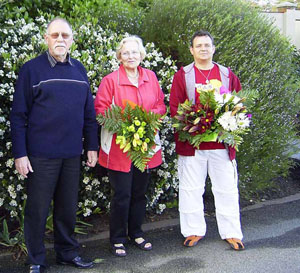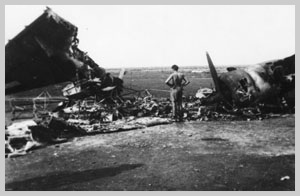

Centre: Willy Josina Maria van Aggeren is a survivor of the Broome bombing, rescued as a baby by one of the pilots. Both her parents were killed in the tradgdy and she was later adopted by her rescuer. On the right is her grandson.
Japanese attack
Now in Australia, the Dutch evacuees thought themselves safe from the Japanese. But shortly after their arrival at 9.30am on 3 March, nine Japanese Zero fighters accompanied by a Japanese reconnaissance plane brutally attacked the unprotected aircraft. As the Zeros made slow fly-pasts with open cockpits, parents pushed their children into the water in an effort to save them.
There were many heroic acts. For example Willy Josina Maria van Aggeren, who lost both her parents that day, was ferried to safety on the chest of the pilot who later adopted her.
The massive loss of life included four Lokman children, both parents and two siblings survived. The bodies of Hendrika, Jeanette, Jan and Johannes Lokman were never recovered. The entire Brandenburg family: father, mother and child; Pieter Schraver and his wife and Mrs Kuin and her child all died as did the Hendrikse, who were found dead wrapped in an embrace – she could not swim so he made the ultimate sacrifice.

One of the six aircraft, probably a Liberator, destroyed on the Broome aerodrome, 3 March 1942. Australian War Memorial P02039.003.

The burnout remains of an aircraft from the bombing of Broome, 3 March 1942. Australian War Memorial P02039.004.
Eyewitness accounts
Eye-witness reports describe the ensuing 20 minute attack as a horrific massacre with survivors recalling that even under water you could hear the noise and feel the pressure of the Japanese bullets.
A Broome resident recalls: “[T]he rat-tat-tat of their machine guns was followed by a spectacular display of fireworks [as the Japanese] used incendiary bullets...They...set fire to everything they hit. In a few minutes the whole of the harbour was covered by a pall of thick, black smoke...”
As one Australian military personnel noted when the attack began: “I saw the red bursts of the guns from the two leading planes, the white plumes racing across the water...[T]he faces at the window [of the flying boat] were contorted with panic, terror-stricken fingers clawing at the glass…Two of the women and four children died in the plane. Fourteen made it to the lighter – five women and nine children...two of the women and one of the children were badly burned...their skin cracking and lifting, the flesh shrivelling and turning a reddish-brown… I turned to the two youngsters, both little girls, who had been hit by bullets. One of them had fainted...The other just sat and stared at the shattered stump of her arm.”
The Australians took a lighter (fuel boat) out to rescue the survivors: “[T]here were floating pools of fire about all the boats and we could see figures leaping from the boats into the fire...There were heads bobbing about in the water...We slowed, and bent over the side of the lighter, dragging them into the lighter. I was weak inside with revulsion at the way some of them were burned… I leaned over and lifted a little boy, whose head was singed and bald... The planes came in again…I saw the nose of one dip and...I watched him come down growing bigger fast, blotting out the sky, and I heard the bullets coming across the lighter, and then he was gone…I turned and the first thing I saw was the little kid I had just dragged out of the water... A bullet had hit him in the face.”